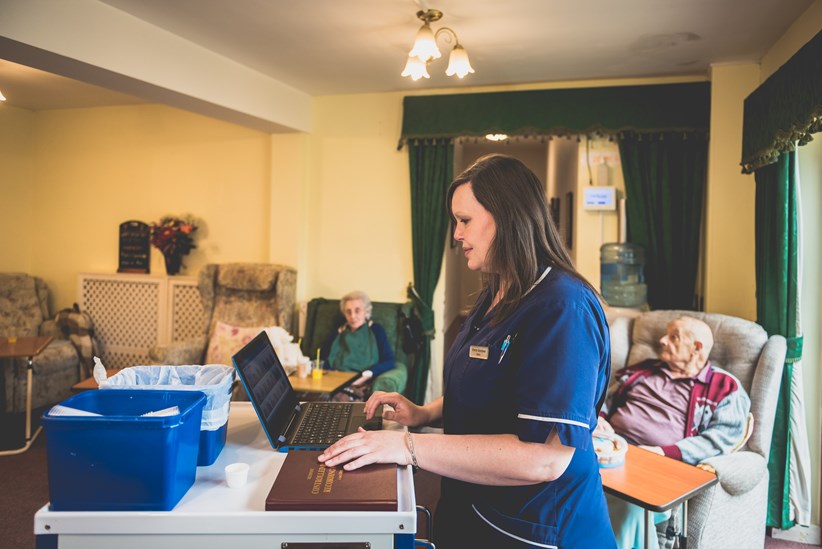
Care Home Software and Integrations: 11 Benefits to Consider
If you are looking for the best care home software you’ve probably come across lots of companies describing their software as ‘integrated’ and wondering exactly what that means and why it is important.
At The Access Group we work hard to provide you with integrated care home software and software modules to all care homes regardless of their type and size.
 10
10

Written by Claire Wardle
We’ve added lots of new systems and modules over the years and have seen how much of a difference it can make to care services like yours, when these systems and modules are integrated, when they share data and ‘talk’ to each other.
We’re not the only provider of care home software with strong integrations though. It is something most software providers will at least try to do. There’s a reason for that. Integration or lack thereof can make a huge difference to safety and care quality. It can also be accounted for in hours and pounds spent.
This article will explain how integrated care home software works, what is integrated care software and the top 11 reasons why the care home software you use needs to be integrated.
After reading this article you will be better equipped to understand what integration is, why it is important and know what to look for when assessing different care home software options and finding the best for you.
How does integrated care home software work?

Care home software manages all aspects of a care home to replace the paper world and help improve the efficiency of managing day-to-day tasks and general management of a care home.
When different care home software or systems are integrated it improves the functionality of both systems, by allowing the transition of information and data from one system to another system to happen effortlessly.
It also makes the process of inputting data and information happen faster, sometimes instantly, as one system feeds information into another. This also prevents the need for support workers or care home managers to reinput the same data into another system.
Using integrated care home software therefore, offers real-time information to be inputted and fed through to other modules or processes so support workers can access the most up-to-date information to deliver the best quality of care.
Now, it is not essential that every piece of software you use is fully integrated. Some systems don’t need to share data with each other. As a rule of thumb, if you find yourself, or a colleague is regularly typing in information from one system into another though, it’s a sign there should be an integration in place.
Top 11 reasons why your care home software should be integrated
1. Pre-empts and prevents risk
When making any decision in a care home one of the most important things to think about is how it will impact your residents. Using integrated care home software ensures patient safety by both pre-empting and preventing risks.
For example, we all know that the medications a person is taking can affect their mood, increase risks of falls and so on. Conversely, if some one has refused their medicine that can also have adverse side effects.
Without integration
So, if you are using paper MAR or even an eMAR or medicine management system that is not integrated with your care records software then it’s likely a care worker will not always be aware of changes to a person’s medicine regime, new medicines and their side effects, any PRNs they have taken, medications that have been refused earlier that day and so on.
Even if the care worker has the information in a separate app on the mobile or tablet, you are then reliant upon them to switch constantly back and forth between the care plan app and the medication app as they deliver care.
With integration
If the medication system/eMAR system is integrated with the care planning system (and mobile/tablet app) the care worker uses as they deliver care, then they will know exactly what medications the person is currently taking, what they have taken or not taken that day.
Your care staff have this information, which is always up to the minute up to date, in the palm of their hands at all times. Whether in the ‘news feed’ on the app or within the care plan/notes for the resident they are interacting with.
Armed with this information, staff can take appropriate precautions, for example providing extra physical support, adjusting the way they interact with a person who may be extra confused, be on the lookout for the signs of any serious side effects or avoid giving food or drink that may have an interaction with the new medication.
Without this flow of information from medication system to care plan system, the care worker is somewhat in the dark. Or at least lacking the full picture. This is just one example of how information flow through integrated care software can improve the well-being, outcomes and safety of the resident being cared for.

2. Improves resident safety through investigations
After an incident occurs you will want to understand why so that you can take steps to reduce the chance of recurrence.
During these investigations you will be looking to make links between different factors and outcomes. For example, of those people who have had falls, or behavioural issues, how many have been taking certain medications, or is there a pattern by location, or equipment used and so on.
Without integration
Gathering together all the information to find these kinds of patterns and connections in the examples below will take an enormous amount of time and movement from one system to another.
You’re going to need to hope human error doesn’t become a factor and lead you to miss some important information that could uncover a key factor that is causing incidents or risks.
With integration
Depending on how sophisticated the integration is you will be able to easily access and identify the relevant information within one system.
In the case of the examples above you can filter by people who are have had a specific type of incident in a time period and see, or even further ‘drill-down’ by what medicines they are taking, present health conditions, equipment used, if staff don’t have certain qualifications and so on.
This means the system takes care of a really complex, time consuming problem for you, by combining data from different systems or modules to identify a cause, or groups of causes behind incidents or positive outcomes too.
Even where the system cannot tell you the answers, integration helps the investigator by making the information much easier to access and work through more efficiently.
3. Reduces admin time
One of the clearest benefits of integrated care home software is it reduces admin.
Without integration
Lots of information needs to be ‘re-keyed’ or re-entered from one system into another, adding up to hours of work each week. Hours that could be spent with residents, taking steps to improve quality, find more staff or other more valuable task than data entry.
With Integration
With integration the information from one system automatically flows into the other/s so there is no need to re-key. This means the money your care home is spending on staffing goes directly to the provision and improvement of care, not data entry tasks. You’ll probably notice this improves morale too.
4. Prevents discrepancies between records in different systems
Similar to reducing admin time, integration reduces the chances of your different systems saying different things about the same resident or staff member. For example, which medications they are taking or the most recent observations for a resident.
Without integration
The latest information from one system, for example medicines prescribed to a person in your eMAR system will need to be manually entered into your care records system. For the space of time before this happens your systems are saying two different things about the same resident.
When people are manually entering that data there is of course the possibility for human error, a simple slip on the keyboard can mean your two systems now have two different sets of information.
At best this is a data quality issue – under GDPR it is a legal requirement for the records you hold on a person to be correct - at worst it could present a risk to well-being or even health.
With integration
When systems or modules are integrated the flow of information is usually constant, or very quick meaning the space of time where two versions of the same information are in circulation in your care home is greatly reduced.
In addition, when information is automatically shared between systems you don’t need to worry about human error during data entry and all the risks that can carry.
During inspections regulators are often keen to see whether the information matches. Through integrating the processing of information across these two areas any changes in one can automatically flow into the other.
5. Improves care planning processes
A key part of providing care is assessing, and re-assessing people’s care needs and preferences, and producing a care plan based in large part on this information.
One of the first things managers and care inspectors will look for is whether the information in a care plan matches the information in your latest assessment.
If the information doesn’t match then realistically care workers do not have the correct information to deliver care to each resident.
Without integration
If the modules of your software that handle assessments and care plans and care planning are not integrated, then there is a risk that any changes in a risk assessment for a resident might not be included in the care plan, resulting in the care plan being outdated.
With integration
When these processes within your software are integrated, new information from the risk assessment automatically updates the care plan. Support workers and carers will be aware and notified when something in a resident’s care plan changes.
One example, could be if a resident has experienced an injury and is now in a wheelchair their risk assessment would need updating, particularly regarding fire drill procedures. Integrating software would allow these changes to update the care plan automatically so all resources have the most up to date information.

6. Improves data security and integrity
Not all care home software offers modules that can be integrated or integrated well, so some care homes have different care home software for different information. This can lead to multiple passwords making password control very complex.
Like a lot of us, it can be hard to remember multiple passwords. People will often we either make them all the same or similar so they are easy to remember, or write them down, especially when more than one person needs access to an account.
This of course is not going to pass any tests for data security as anyone who gets into your office can easily access your systems and all the confidential information on them. It can make data breaches more likely and if found to be failing to keep people’s data secure you could face large fines.
Likewise when systems are not integrated people will often export information from system A into a CSV file, then upload it to system B. This means you now have an unprotected version of sensitive data on your computer or laptop.
If your systems are integrated there is no need to download and upload data between systems, so that sensitive data does not run the risk of being exposed during the process.
Using software that is integrated to the point that it has a single sign on, such as Access Workspace for Care reduces the need for multiple passwords, making it easier to keep data secure.
7. It’s easier to use
As well helping support workers and care workers, using integrated care home software can help the care home manager. Using software where modules and information can be integrated can improve the user interface and user experience as the modules in a software will be consistent in how they work and look.
You may think that one app providing all modules in one space would be more efficient. However, with the variety of tools and modules a care home may need and will want to utilise, you could be at risk of using an app which is more difficult to navigate making the time spent accessing certain information longer.
By using apps and modules that are consistent looking it makes learning how to use them for both care home managers and support workers easy. Once you learn how to use one the rest will be similar if not the same. Data can be shared between the apps which can then be used in reports to assess the efficiency of a home, and evaluate where you need to improve.
8. Enables better reporting
Through integrating software, tools to measure, monitor, and track data across modules can be possible. In an ideal world all information regarding a resident’s care would be presented in one single report, however this is not always possible.
Access Workspace for Care allows modular reports to be cross-compared to identify any potential gaps or interesting patterns in data which without the software may not be identified.
Through cross comparing data across modules and processes with Access Workspace for care, registered managers can easily identify their priorities and identify how different elements of care are affecting their outcomes. This can be even more significant if a care home or care home agency have multiply branches as metrics and tools to measure outcomes on Access Workspace can be used to identify both individual priorities for each branch as well as a priorities for the whole agency.
By cross-comparing results in reports across the different modules in Access Workspace risks can be flagged quickly, especially when a problem is affecting more than one area of how a care home is run.
For example by comparing hydration levels to care plans and audits if all the data across the three modules are low it is clear for the registered care home manager to adapt their audit accordingly to ensure residents reach their hydration levels. Through doing this their quality of care delivered is improved and will prevent severe illnesses from dehydration occurring because the problem would be flagged before it occurred.
9. It can help with regulatory compliance
The integration of care home software makes it easier to present information to your national care regulator (e.g. CQC, Care Inspectorate Scotland, RQIA, Care Inspectorate Wales) when they inspect.
During an inspection it’s important to be able to produce the evidence required to show you are meeting the regulations. It is much easier to do this when the information can be accessed in one system, especially when you add in the nerves of an inspection.
When processes such as auditing to action planning are integrated its much easier to show you are aware of any issues and taking action to address them, which is something inspectors really want to see.

10. Gives a complete picture of your team members in one record
Integrations between the systems or modules used to manage employee records and processes can create a single, cohesive record for each employee. Integrations between systems can also help drive all of the processes involved with hiring, screening (Right to Work, DBS checks and so on), managing staff, training and even if and when they leave your employment.
This is far more efficient, for example in Access Workspace for Care when an employee completes a piece of training, their employee record is also updated with this information.
Additional modules within Access Workspace for Care can also be used to track individual employee’s performance. The direct acknowledgement of their good work in Access Applause can motivate and provide incentives for employees to keep up their good work.
Without integration you’re facing lots of manual data entry which as points 3 and 4 above show, means more working hours and greater potential for errors.
Bringing all this data together means you can analyse underlying factors behind staffing issues, for example sickness, people leaving shortly after joining and so on. There may be patterns here that you can address and it makes it much easier to build that picture when systems are integrated.
Not every integrated system automates process. But when it does it can save lots of time and ensure processes are followed correctly. Without integration and automation each step in the process of hiring and managing employees needs to be driven manually, rather than the system automating each step in the process.
If systems used to manage recruitment are not the integrated with those used to manage HR and employee management then you lack the full picture of the employee when you access either system or module.
For example, there could be a situation where an employee was fired for some reason, even gross misconduct (recorded in your HR system), then another care home in your group could hire this person without knowing they have been fired previously, all because the systems or modules used to hire and fire are not integrated and do not share data.
11. Makes auditing easier and more effective
Auditing in care homes will always require someone to interpret the information, make assessments and put action/improvement plans in place.
But without software integration, gathering that information takes much longer, as information needs to pulled from multiple systems one by one.
With integration, or with a comprehensive auditing and governance system, much of the information is already collated into a single area so that you can spend more time on actual auditing rather than information gathering.
Why should your care home software be integrated?
After reading this article you should have a much better understanding of the many varied reasons why having care home software that is integrated benefits you, your care home, and everyone in it.
When automation and integrations are combined it allows everything to move forward properly with minimal effort from you, your care workers, or managers. It leaves you feeling confident that the likelihood of errors is reduced by ensuring all information regardless of the system or module is the same, improving both the safety and efficiency of your care home.
Now, it is important to state that not each and every one of your systems needs to integrate. Certain information is rarely going to necessary to have in every system. As you read at the start, a good rule of thumb is when you find that a lot of time is spent doing data entry for a set of information, there is probably just cause for an integration to be in place.

Our integrated offering for you
At The Access Group we not only offer integrated software or modules, but a single system where all these bits of the jigsaw reside. This system is called Access Workspace for Care.
You need one login to use Access Workspace for Care and within it you can access every module you care home uses, from your care record system, your medicine system, the tools you use to recruit and manage staff all the way through to audits and compliance.
Analytics within Access Workspace for Care combines data from all the different tasks and processes you use these modules for into reports and dashboards. This gives you the power to understand not only how your care home is performing but why. This could relate to standards of care, recruiting staff, or your care home’s finances and expenditure.
Access Workspace for Care is unique in its analytics capability and the breadth of modules available, all within one system. But of course, Access Workspace for Care is not unique in having integrations between the tools you will use to manage and deliver care.
Regardless of the care home software you are reviewing, make sure you understand which bits are integrated and how, to ensure you get the maximum benefit from your software investment.
At The Access Group we’ve got decades of experience equipping care homes with the best software available. To see what we have to offer you, or to talk through some of your questions or concerns about which care home software will be best get in touch here and let’s get that conversation started.



